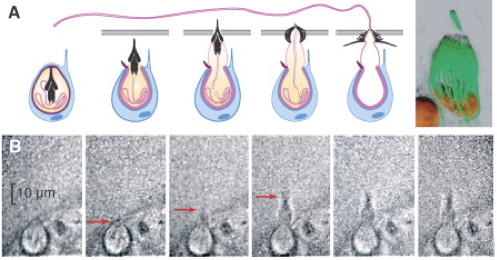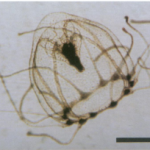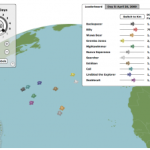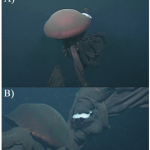
A link from one of readers (thanks Ashley!) pointed us to a story on MSNBC about a very large Lion’s Mane jellyfish (Cyanea capillata) that broke apart and stung up to 100 people on a New Hampshire beach last Wednesday. Lion’s Manes can get very big, their bell can be over 3 feet. Their tentacles though are another story and quite intimidating! A small Lion’s Mane can have a tentacle trail 10 feet long. A much larger one may have over 150 tentacles trailing over 30 feet behind it!
So how can jellyfish sting if they break apart or are dead and washed up on the beach? The tiny stinging cells, called nematocysts, can be thought of like a mouse trap. One you set the mouse trap it only needs a trigger to do its damage. It doesn’t need any outside help to be maintain. It just has purpose, to sit and wait for an unfortunate victim to trigger the hard-wired response that millions of years of evolution have refined into a potent venom delivery system. Much the like the mouse trap, once set it does not let go easily.
From MSNBC/LiveScience writer Jeanna Bryner:
Though not a common occurrence, marine biologist Sean Colin says with such a large jellyfish, and so many trailing tentacles (not to mention those that break off in the water), the occurrence is feasible.
“It’s certainly not common, but it’s certainly in the realm of possibility, because they do have so many tentacles if they’re that large. If they’re broken up they could be all over the place,” said Colin who is at Roger Williams University in Bristol, R.I.
Profile of a giant
This species is typically found in the cooler regions of the Pacific Ocean, Atlantic Ocean, North Sea and Baltic Sea. And they rarely show up on this beach. “I haven’t seen anything like this in my life, said Brian Warburton, who has been with the New Hampshire State Parks department for six years.All the action transpired in about 20 minutes, when Warburton and his colleagues administered first aid (vinegar treatment). “There wasn’t time to sit and measure this thing. We just got rid of it,” Warburton told LiveScience. “Think about a glob of Jell-O you’re trying to pick up with two hands,” he said, explaining the need for a pitchfork to pick it up.

Nematocysts are proteinaceous substances and are not living cells or organelles. They discharge extremely rapidly and work by building an immense amount of pressure inside the cell (up to 15 MPa or 2176 lbs/in2) by storing oodles of calcium ions. When discharged (see above), the ions are rapidly ejected into the surrounding cytoplasm, setting off the chain of events resulting in a painful sting. Research by Nüchter and colleagues measured the escape velocity and kinetics of nematocyst discharge in the freshwater hydrozoan, Hydra. The steps above took place during 700 nanoseconds, creating an acceleration of 5,410,000 g!
Not all nematocysts are filled with venom though, but it is not a chance you should be willing to take. Since the stinging cells matter not whether its creator is alive (at least over the shorter term, the protein does degrade rapidly), it still does a lot of damage on its own its always a good idea to approach a beach jellyfish with caution and your flippy-floppies on. Very important to make sure your kids know never to touch a jellyfish unless with a stick from a safe distance. As I tell my 3 children, jellyfish are pretty from a distance!
Nüchter, T., Benoit, M., Engel, U., Özbek, S., & Holstein, T. (2006). Nanosecond-scale kinetics of nematocyst discharge Current Biology, 16 (9) DOI: 10.1016/j.cub.2006.03.089






Jellyfish stings can really do some damage. My mother still has a scar from a rather nasty sting she received while snorkeling about 3 years ago.
Was diving in Haida Gwaii British Columbia a few years ago. My buddy and I were ascending holding onto the anchor line in a stiff current, flapping like flags in the breeze. He was below me and suddenly started signaling me with his light. Took me a sec to realize what he was getting at and I looked up just in time to see the big Lion’s Mane jelly right as it smacked me flush in the face. The exposed skin around my mask and regulator was still stinging 4 hours later (and my buddy was still laughing!).
Wow Clinton! That was a too-close-for-comfort encounter! Cool story though, glad to see you’re not afraid to get back into the water.
Hi Kevin, At least in my experience the Lion’s Mane Jellies are more of a nuisance than anything actually dangerous. If you’re in the water with them it’s nearly impossible not to get stung at least a little bit by the long and nearly invisible tentacles. Being stung does hurt but it’s not _that_ bad. Tropical jellies are another matter and can really hurt. Meanwhile Lion’s Manes are interesting (and fairly common) photo subjects and I’ve never heard of anyone being seriously hurt by one.
As a piece of jellyfish trivia – there is a Sherlock Holmes story where this very jellyfish is the murderer. The victim crawled ashore screaming & died…..
We once had to do a dive where there was a layer of stinging jellies between us & the bottom. By gently pokig the bells we got enough of them to retract their tentacles to make a hole to go through. Going back up was another story – stung lips all round! Still, they are beautiful.